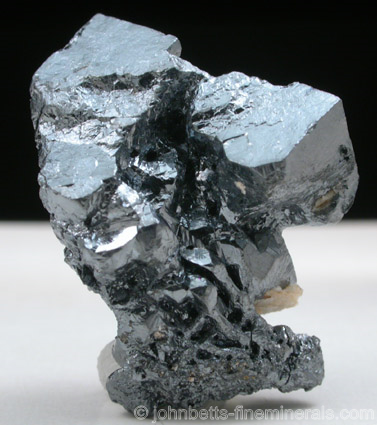The Mineral acanthite

Acanthite is composed mostly of silver, and is its most important ore. Acanthite and Argentite are usually grouped together in mineral guides as one mineral. However, they are scientifically recognized as two unique minerals, even though they are composed of the same substance. They only differ in crystal structure. As explained below in more detail, Argentite cannot exist at normal temperatures. Specimens labeled as Argentite are sometimes sold by dealers, however, these specimens are really Acanthite pseudomorphs after Argentite.
Acanthite is named for the Greek term akantha, which means "thorn", in allusion to it pointy crystal forms. Argentite is named for argentum, which is the Latin word used for silver.
Color
Silvery gray to dark gray
Crystal System
Monoclinic
Properties
Streak
Black. Streak shiny. |
Hardness
2 |
Transparency
Opaque |
Specific Gravity
7.2 - 7.4 |
Luster
Metallic. Heavy tarnish may cause it to become dull. |
Cleavage
3, all sides. Indiscernible. |
Fracture
Subconchoidal |
Tenacity
Malleable and sectile |
Other ID Marks
May tarnish dark gray. |
Crystal Habits
Acanthite crystallizes in the monoclinic system, and Argentite crystallizes in the isometric system. However, the crystal structure of Argentite is unstable at temperatures below 356° F (180° C), and below that temperature its crystal structure will change to Acanthite, though retaining the isometric crystals of Argentite. Therefore, Argentite specimens are really Acanthite pseudomorphs after Argentite.
Two types of Acanthite exist: monoclinic Acanthite (Acanthite that formed naturally as Acanthite, and is not a pseudomorph after Argentite) and Acanthite pseudomorph after Argentite. Monoclinic Acanthite occurs as distorted elongated prisms, and Acanthite pseudomorph after Argentite occurs as distorted groups of cubes, octahedrons, and dodecahedrons.
Crystals are usually in parallel groups. The most prevalent aggregates are groupings of distorted octahedrons and dendritic growths, but it also occurs as a coating and massive. Individual cubes, octahedrons, and modified dodecahedrons do exist, but are uncommon.
Uses
Acanthite is the most important ore of silver. It is a popular mineral in high-end collections, with well-crystallized specimens being highly sought after by collectors and commanding high prices.
Noteworthy Localities
Fine Acanthite specimens have come from Kongsberg, Norway, where it occurs with Silver. Important specimens have also come from several localities in Germany, notably the Clara and Wenzel mines in the Black Forest, and in Freiberg and Scheenberg, in Saxony. An excellent producer of Acanthite is the Imiter Mine in Morocco, as well as the Hongda Mine, Shanxi Province, China.
In South America, Acanthite is found in the Uchucchacua Mine, Oyon Province, Peru. There are numerous localities in Mexico. The most significant are Batopilas, in Chihuahua; the San Juan de Rayas Mine in Guanajuato; and Cerro Proaño, Fresnillo, in Zacatecas.
In the U.S., Acanthite has been found in the Comstock Lode, Virginia City, Nevada; Butte, Silver Bow Co., Montana; the Bulldog Mountain Mine, Creede District, Mineral Co., Colorado; and the White Pine Mine, Ontonagan Co., Michigan. In Canada, Acanthite has come from the silver mines of Cobalt, Timiskaming District, Ontario.
Distingushing Similar Minerals
Silver - Lighter color, more malleable, not sectile.
Chalcocite - Different fracture (conchoidal).
Galena - Good cleavage, different tarnish, no sectility.